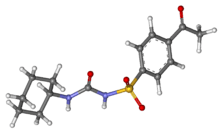Acetohexamide
Not to be confused with acetazolamide.
 | |
 | |
| Clinical data | |
|---|---|
| Trade names | Dymelor |
| AHFS/Drugs.com | Micromedex Detailed Consumer Information |
| MedlinePlus | a602021 |
| ATC code | A10BB31 (WHO) |
| Pharmacokinetic data | |
| Protein binding | 90% |
| Identifiers | |
| |
| CAS Number |
968-81-0 |
| PubChem (CID) | 1989 |
| IUPHAR/BPS | 6793 |
| DrugBank |
DB00414 |
| ChemSpider |
1912 |
| UNII |
QGC8W08I6I |
| KEGG |
D00219 |
| ChEBI |
CHEBI:28052 |
| ChEMBL |
CHEMBL1589 |
| Chemical and physical data | |
| Formula | C15H20N2O4S |
| Molar mass | 324.395 g/mol |
| 3D model (Jmol) | Interactive image |
| |
| |
| (verify) | |
Acetohexamide (trade name Dymelor) is a first-generation sulfonylurea medication used to treat diabetes mellitus type 2, particularly in people whose diabetes cannot be controlled by diet alone.
Mechanism of action
Acetohexamide lowers blood sugar by stimulating the pancreas to secrete insulin and helping the body use insulin efficiently.[1] The pancreas must produce insulin for this medication to work. For this reason, acetohexamide is not used to treat diabetes mellitus type 1.
Risks
Oral hypoglycemic drugs, including acetohexamide, have been associated with increased cardiovascular mortality. Talk to your doctor about the possible risks, benefits, and alternatives of using this drug for your condition.[2]
References
- ↑ "Archived copy". Archived from the original on 2011-11-05. Retrieved 2011-10-26. - Metformin Side Effects
- ↑ Medline Plus Archived September 11, 2005, at the Wayback Machine. - Acetohexamide
This article is issued from Wikipedia - version of the 11/17/2016. The text is available under the Creative Commons Attribution/Share Alike but additional terms may apply for the media files.